Pesaro
Pesaro (Italian pronunciation: [ˈpeːzaro] (![]() listen)) is a city and comune in the Italian region of Marche, capital of the Province of Pesaro e Urbino, on the Adriatic Sea. According to the 2011 census, its population was 95,011, making it the second most populous city in the Marche, after Ancona.
Pesaro was dubbed "Cycling City" (Città della Bicicletta) by Italian environmentalist association Legambiente in recognition of its extensive network of bicycle paths and promotion of cycling.
It is also known as "City of Music" as it is the birthplace of the composer Gioacchino Rossini. In 2015 the Italian Government applied for Pesaro to be declared a "Creative City" in UNESCO's World Heritage sites. In 2017 Pesaro received the European City of Sport award together with Aosta, Cagliari and Vicenza.
listen)) is a city and comune in the Italian region of Marche, capital of the Province of Pesaro e Urbino, on the Adriatic Sea. According to the 2011 census, its population was 95,011, making it the second most populous city in the Marche, after Ancona.
Pesaro was dubbed "Cycling City" (Città della Bicicletta) by Italian environmentalist association Legambiente in recognition of its extensive network of bicycle paths and promotion of cycling.
It is also known as "City of Music" as it is the birthplace of the composer Gioacchino Rossini. In 2015 the Italian Government applied for Pesaro to be declared a "Creative City" in UNESCO's World Heritage sites. In 2017 Pesaro received the European City of Sport award together with Aosta, Cagliari and Vicenza.
Pesaro | |
|---|---|
| Città di Pesaro | |
 Monte Ardizio | |
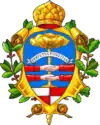 Coat of arms | |
Location of Pesaro 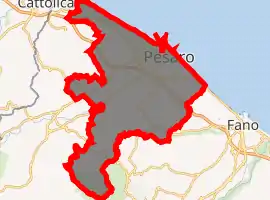
| |
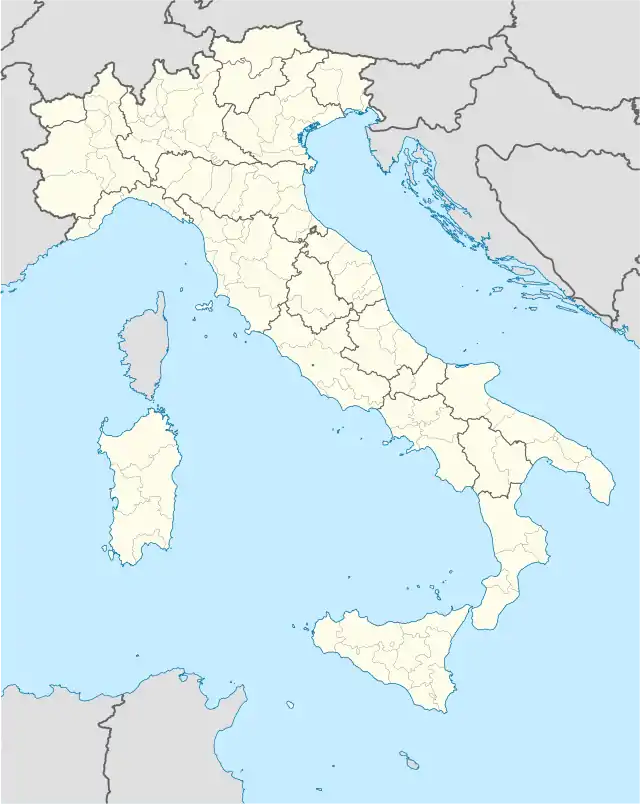 Pesaro Location of Pesaro in Italy  Pesaro Pesaro (Marche) | |
| Coordinates: 43°55′N 12°54′E | |
| Country | Italy |
| Region | Marche |
| Province | Pesaro e Urbino (PU) |
| Government | |
| • Mayor | Matteo Ricci (PD) |
| Area | |
| • Total | 126.77 km2 (48.95 sq mi) |
| Elevation | 11 m (36 ft) |
| Population (21 October 2011)[2] | |
| • Total | 95,000 |
| • Density | 750/km2 (1,900/sq mi) |
| Demonym(s) | Pesaresi |
| Time zone | UTC+1 (CET) |
| • Summer (DST) | UTC+2 (CEST) |
| Postal code | 61121, 61122 |
| Dialing code | 0721 |
| Patron saint | St. Terence |
| Saint day | September 24 |
| Website | Official website |
Local industries include fishing, furniture making and tourism.
History
The city was founded as Pisaurum[3] by the Romans in 184 BC as a colony in the territory of the Picentes, the people who lived on the northeast coast during the Iron Age. However, in 1737, 13 ancient votive stones were unearthed in a local farm field, each bearing the inscription of a Roman god; these were written in a pre-Etruscan script, indicating a much earlier occupation of the area[4] than the 184 BC Picentes colony.
A settlement of the Picentes tribe has been found at Novilara. The northern Picentes were invaded in the 4th century BC by the Gallic Senones, earlier by the Etruscans, and when the Romans reached the area the population was an ethnic mixture. Within it the Gauls at least were still distinct, as the Romans separated them out and expelled them from the country.
Under the Roman administration Pesaro, a hub across the Via Flaminia, became an important center of trading and craftmanship. After the fall of the Western Empire, Pesaro was occupied by the Ostrogoths, and destroyed by Vitigis (539) in the course of the Gothic War. Hastily rebuilt five years later after the Byzantine reconquest, it formed the so-called Pentapolis, part of the Exarchate of Ravenna. After the Lombard and Frankish conquests of that city, Pesaro became part of the Papal States.
During the Renaissance it was ruled successively by the houses of Montefeltro (1285–1445), Sforza (1445–1512) and Della Rovere (1513–1631). Under the last family, who selected it as capital of their duchy, Pesaro saw its most flourishing age, with the construction of numerous public and private palaces, and the erection of a new line of walls (the Mura Roveresche). In 1475, a legendary wedding took place in Pesaro, when Costanzo Sforza and Camilla d'Aragona married.[5]
On 11 September 1860 Piedmontese troops entered the city, and Pesaro was subsequently annexed to the new Kingdom of Italy (see also Battle of Castelfidardo).
Government
Main sights
Civic Sites
- Ducal Palace (15th century): Commissioned by Alessandro Sforza, the façade has a portico with six arcades supported by six heavy pilasters and an upper floor with five windows crowned by coats of arms, festoons and puttoes.
- Rocca Costanza (15th century): Massive castle built by Costanzo I Sforza; it has a square plan with four cylindrical corner towers and a wide dry moat. Later used as prison.
- Villa Imperiale of Pesaro (c. 1530): Suburban palace with gardens designed by Girolamo Genga for Duke Francesco Maria Della Rovere and his duchess Eleanora[6] and built from c. 1530 onwards, stands atop the San Bartolo hill. Its sunken court is the direct precedent for the more famous one at the Roman Villa Giulia.[7] Rooms are frescoed by prominent Mannerist painters Bronzino, Francesco Menzocchi, Girolamo Genga, and Raffaellino del Colle.
- Mura Roveresche (17th century): "Della Rovere Walls", demolished in the early 20th century), only two gates, Porta del Ponte and Porta Rimini, and a short section remain.
- Birthplace of Gioachino Rossini: Now a museum dedicated to the composer, located at 34 Via Rossini. It has a museum with manifestoes, prints, portraits and his spinet.
- Conservatorio Statale di Musica Gioachino Rossini: Located in the 18th century Palazzo Olivieri–Machirelli on the Piazza Oliveri
- Musei Civici di Palazzo Mosca: Civic museum contains mainly paintings and ceramics. Among the masterpieces is the Pesaro Altarpiece by Giovanni Bellini.
- Oliveriano Archeologic Museum and Oliveriana Library:[8] Archaeological Collection and Manuscript Library; founded in 1756 by Annibale degli Abati Olivieri.
Religious Sites
- Pesaro Cathedral (5th-14th centuries) Romanesque-Gothic Basilica built over remains of a late Roman edifice and dedicated to St Terence during the Middle Ages. The façade, in Romanesque-Gothic style, is unfinished: it has a simple ogival portal surmounted by a band of small arches. A recent restoration has brought to light floor mosaics.
- The Baroque Sanctuary of Beata Vergine del Carmelo (18th century).
- Church of the Maternità
- Santissima Annunziata
- Oratory of the Nome di Dio
- San Giacomo
- San Giovanni Battista
- Sant'Agostino
- Santa Lucia
- Municipal Chapel of Sant'Ubaldo
- Church and Convent of the Girolimini
- Madonna del Porto
- Santa Maria delle Grazie
- Pieve di Ginestreto
- Pieve di Santo Stefano
- Santa Veneranda
- Sacred Grove of Lucus Pisaurensis, pre-Roman era sacerdotal lucus
Gallery
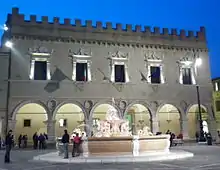
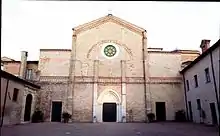
 Rocca Costanza
Rocca Costanza Musei Civici Pesaro
Musei Civici Pesaro Monte Ardizio and Beach
Monte Ardizio and Beach
Culture
- The Pesaro film festival (Mostra Internazionale del Nuovo Cinema) has taken place in Pesaro since 1965.[9]
- Rossini Opera Festival has taken place every summer since 1980 in Pesaro, home as well as the Conservatorio Statale di Musica "Gioachino Rossini" founded with a legacy from the composer.
- Pesaro hosts the home games of Victoria Libertas basketball team, better known across Europe as Scavolini Pesaro.
- Adriatic Arena: third biggest Italian indoor arena behind Mediolanum Forum in Milan and PalaLottomatica in Rome.
- Among the town industries is the motocross and enduro brand of TM Racing, a small manufacturer of race-ready motorbikes based in the coastal town since 1978.
Frazioni
The municipality of Pesaro includes also the villages and towns (frazioni) of Borgo Santa Maria, Candelara, Case Bruciate, Casteldimezzo, Cattabrighe, Chiusa di Ginestreto, Colombarone, Fiorenzuola di Focara, Ginestreto, Monteciccardo, Novilara, Ponte Valle, Pozzo Alto, Santa Maria dell'Arzilla, Santa Marina Alta, Santa Veneranda, Trebbiantico, TrePonti, Villa Ceccolini, Villa Fastiggi and Villa San Martino.
Notable Pesaresi
- Anna Maria Alberghetti, singer and actress
- Massimo Ambrosini, footballer
- Antonello Bonci, neuroscientist
- Filippo Magnini, swimmer
- Cristiano Mozzati, drummer for Lacuna Coil
- Riz Ortolani, film composer
- Angelo Romani, Olympic swimmer
- Graziano Rossi, motorcycle racer and father of Valentino Rossi
- Gioachino Antonio Rossini, composer
- Giovanni Sforza, condottiero and first husband of Lucrezia Borgia
- Renata Tebaldi, operatic soprano
- Roberto Burioni, physician and professor of microbiology and virology
- Gianni Morbidelli, Formula One driver
International relations
Twin towns – sister cities
See also
- Pesaro railway station
- Alessandro Sforza
- Lucus Pisaurensis
- Votive Stones of Pesaro
- Costanzo Sforza
- Romagna
- Pesaro Angels
| Wikimedia Commons has media related to Pesaro. |
References
- "Superficie di Comuni Province e Regioni italiane al 9 ottobre 2011". Istat. Retrieved 16 March 2019.
- "Popolazione Residente al 1° Gennaio 2018". Istat. Retrieved 16 March 2019.
- etymology - pi (π), plural, and aurum, reflecting gold http://www.italythisway.com/places/articles/pesaro-history.php
- History of Pesarohttp://www.italythisway.com/places/articles/pesaro-history.php
- A Renaissance Wedding: The Celebrations at Pesaro for the Marriage of Costanzo Sforza & Camilla Marzano D'Aragona (26–30 May 1475): (Studies in Medieval and Early Renaissance Art History). Harvey Miller Publ., 2013, ISBN 978-1905375936
- Andrew Hopkins, 2002. Italian Architecture from Michelangelo to Borromini, p.23f.
- Hopkins 2002 p 24.
- Oliveriano Museum http://www.euromuse.net/en/museums/museum/view-m/museo-archeologico-oliveriano
- "Pesaro film festival site".
- "Pesaro". italien.de (in German). Italien.de. Retrieved 2019-12-22.
- "Pesaro". primaria-resita.ro (in Romanian). Reșița. Retrieved 2019-12-22.
- "Si rafforza il gemellaggio Pesaro-Kakegawa. Cerimonia del tè verde con la delegazione giapponese guidata dal sindaco Saburo Matsui". pu24.it (in Italian). PU24. 2019-11-15. Retrieved 2019-12-22.
- "Collaborazione internazionale". rovinj-rovigno.hr (in Italian). Rovinj. Retrieved 2019-12-22.